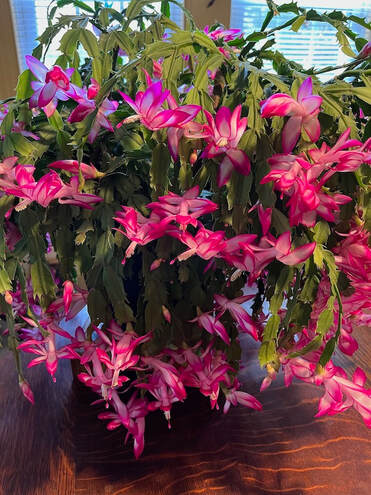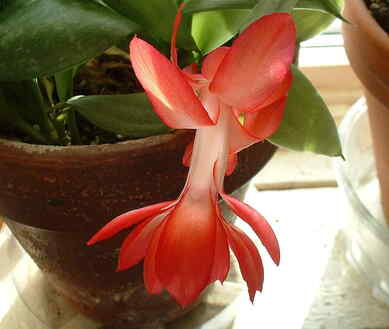|
By Joanne K, Extension Master Gardener Volunteer, Pitt County Arboretum
Although called a cactus, the Christmas cactus does need water, but not too much. It's time to water it when the top couple of inches feel dry to the touch. Don't overwater, as that can lead to stem and root rot. Too little water can cause wilting. A native of shady, humid South American rain forests, this cactus also needs humidity. Place it on a tray with pebbles and water just below the top of the pebbles. Continue this until the cactus stops blooming.
The Christmas cactus likes to be pot-bound. Keep it in a small container as long as possible, and only then transplant it to a slightly larger pot using a mix of half potting soil and half sand or perlite. Late winter or spring is the ideal time to transplant the cactus after the blooms have dropped. Never transplant it while it is blooming.
If needed, prune a cactus just after it has bloomed. This is when it starts to grow. Pruning forces it to branch out and grow more stems. After the danger of frost is over, move your plant outside to an area with bright, indirect light. Too much sun can cause wilting or stem burn. To encourage budding in the fall, 16 hours of uninterrupted darkness, 8 hours of daylight, and cooler temperatures are required. To stimulate bud formation, don't fertilize or overwater at this time. Avoid moving the plant because doing so can make the buds may fall off. Once buds form, the light/dark regiment ends. Continue watering but don't fertilize. Move indoors when temperatures below 50° F are predicted. However, spray with water before moving the plant to dislodge any insects that may have taken up residence. According to the Old Farmers Alamanac, Christmas cacti can live up to 20 to 30 years. By following the simple guidelines described above, you will enjoy your Christmas cactus for years to come! Pictures: From NCSU Plant Toolbox Christmas Cactus, Schlumbergera russelliana (Also known as Schlumbergera bridgesii) Flowers and stems Wayne Rae Public Domain Mark 1.0 Thanksgiving Cactus, Schlumbergera truncata J. Kollar Bloom: Schlumbergera x buckleyi Tracy from North Brookfield, Massachusetts, usa CC BY 2.0
0 Comments
Leave a Reply. |


